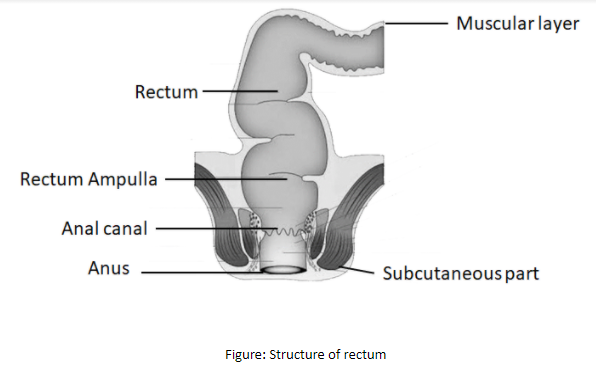
What is the function of the rectum?
Answer
576.6k+ views
Hint: This is a straight portion of the large intestine that connects the colon to the anus in humans and some other mammals. It resembles the shape of the sacrum and ends in an extended section called an ampulla where feces are stored before their release by means of the anal canal.
Complete answer:
The rectum is the last part of the lower gastrointestinal tract. It is a continuation of the sigmoid colon that connects to the anal canal. The rectum used as a temporary storage site for feces where it holds the stool until evacuation happens. The rectum does not have distinct taeniae coli, unlike other portions of the colon. The taeniae blend with one another in the sigmoid colon becoming a singular longitudinal muscle that enclosed the rectum on all sides for its entire length.
Functions of the rectum:
-The rectum collects fecal material from the descending colon and then transmits through regular muscle contractions called peristalsis.
-The electrolytes like sodium, potassium, chloride, etc. get absorbed in the rectum.
-In the rectum, the indigestible food ingredients are decomposed by anaerobic bacteria.
-The rectum is a part of the continence organ that plays an important role in the mechanism of defecation.
-It also supports the defecation through a contraction.
-The voluntary tension of the diaphragm and abdominal muscles increases the intra-abdominal pressure.

Note: -Defecation is the final act of assimilation in which organisms take out solid, semisolid, or liquid waste material from the digestive tract via the anus.
-Proctitis is an inflammation that occurs in the anus and the lining of the rectum which affects the last part of the rectum.
Complete answer:
The rectum is the last part of the lower gastrointestinal tract. It is a continuation of the sigmoid colon that connects to the anal canal. The rectum used as a temporary storage site for feces where it holds the stool until evacuation happens. The rectum does not have distinct taeniae coli, unlike other portions of the colon. The taeniae blend with one another in the sigmoid colon becoming a singular longitudinal muscle that enclosed the rectum on all sides for its entire length.
Functions of the rectum:
-The rectum collects fecal material from the descending colon and then transmits through regular muscle contractions called peristalsis.
-The electrolytes like sodium, potassium, chloride, etc. get absorbed in the rectum.
-In the rectum, the indigestible food ingredients are decomposed by anaerobic bacteria.
-The rectum is a part of the continence organ that plays an important role in the mechanism of defecation.
-It also supports the defecation through a contraction.
-The voluntary tension of the diaphragm and abdominal muscles increases the intra-abdominal pressure.

Note: -Defecation is the final act of assimilation in which organisms take out solid, semisolid, or liquid waste material from the digestive tract via the anus.
-Proctitis is an inflammation that occurs in the anus and the lining of the rectum which affects the last part of the rectum.
Recently Updated Pages
Why are manures considered better than fertilizers class 11 biology CBSE

Find the coordinates of the midpoint of the line segment class 11 maths CBSE

Distinguish between static friction limiting friction class 11 physics CBSE

The Chairman of the constituent Assembly was A Jawaharlal class 11 social science CBSE

The first National Commission on Labour NCL submitted class 11 social science CBSE

Number of all subshell of n + l 7 is A 4 B 5 C 6 D class 11 chemistry CBSE

Trending doubts
10 examples of friction in our daily life

One Metric ton is equal to kg A 10000 B 1000 C 100 class 11 physics CBSE

Difference Between Prokaryotic Cells and Eukaryotic Cells

1 Quintal is equal to a 110 kg b 10 kg c 100kg d 1000 class 11 physics CBSE

State the laws of reflection of light

Explain zero factorial class 11 maths CBSE




